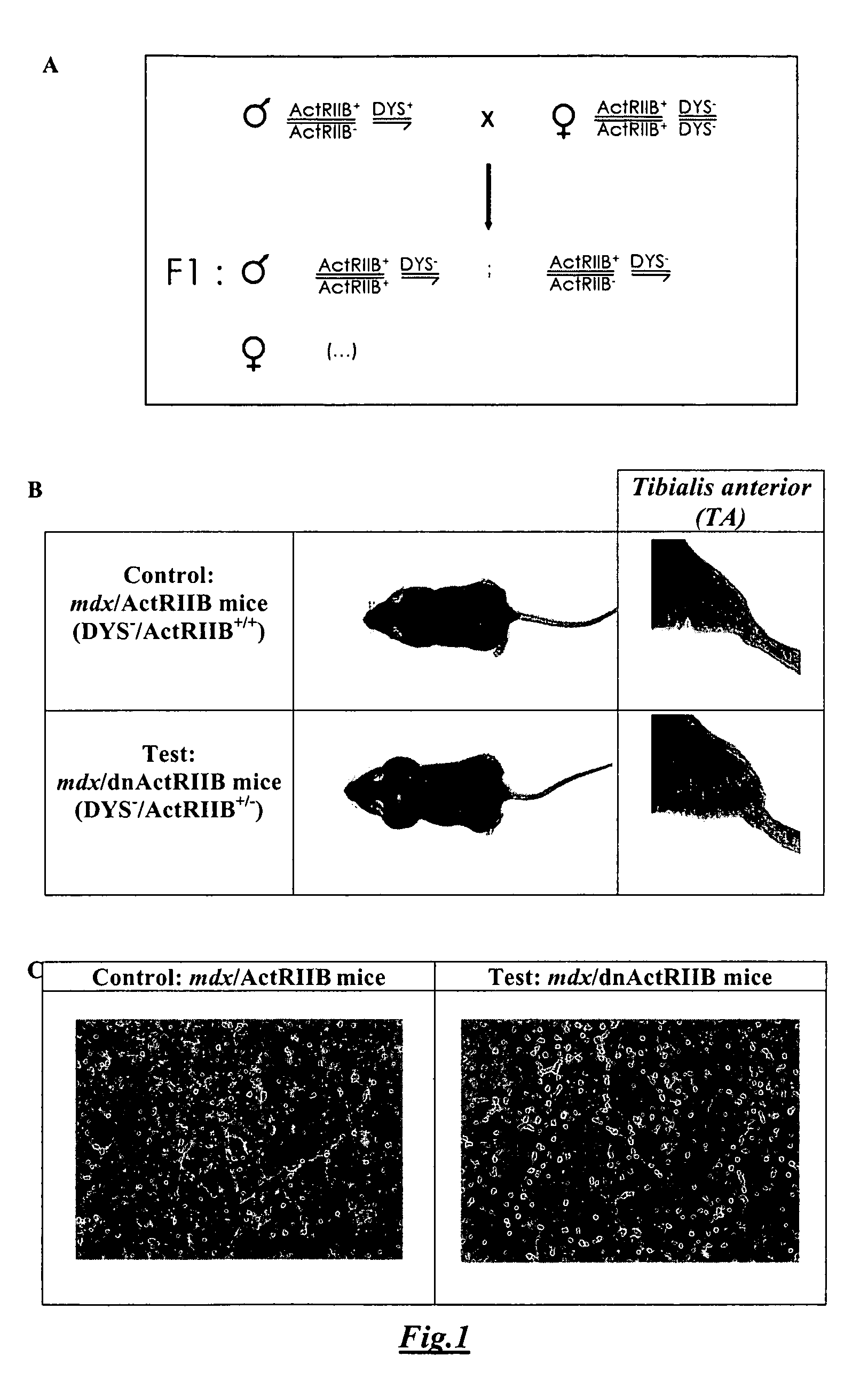Treatment of Duchenne muscular dystrophy with myoblasts expressing dystrophin and treated to block myostatin signaling
a technology of dystrophin and myoblasts, applied in the field of treatment of duchenne muscular dystrophy, can solve the problems of frequent muscle fiber damage and repair, sarcolemmal instability, and serious health problems of muscle disease, so as to prevent or treat muscle disease, increase muscle mass, and increase the proliferation and fusion of muscle fibers.
- Summary
- Abstract
- Description
- Claims
- Application Information
AI Technical Summary
Benefits of technology
Problems solved by technology
Method used
Image
Examples
example 1
Materials and Methods
[0089]Materials: Reagents used in the studies herein were purchased from the following companies: Fetal bovine serum (FBS) from Biomedia (Drummondville, Québec, Canada); penicillin / streptomycin, trypsin, X-Gal from Gibco (Burlington, Ontario, Canada); Hank's balanced salt solution (HBSS), collagenase, Dulbecco's modified Eagle medium (DMEM), Optiprep reagent, gelatin, Evans blue, Notexin from Sigma-Aldrich (St. Louis, Mo.); Dispase from Roche Boehringer (Indianapolis, Ind., USA); hematoxylin from Laboratoire Mat (Beauport, Québec, Canada); eosin from Fisher Scientific (Fair Lawn, N.J., USA); mouse anti-human / mouse desmin antibody from DAKO (A / S, Denmark); rabbit anti-mouse dystrophin was produced in our laboratory as described previously (Camirand et al., 2004). Tacrolimus was obtained from Fujisawa pharmaceutical co. (Osaka, Japan); goat anti-mouse IgG conjugated with Alexa 488, goat anti-rabbit IgG conjugated with Alexa 488 from Molecular probes (Eugene, Oreg....
example 2
Skeletal Muscle Mass Improvement in mdx Mice Carrying a Dominant Negative Form of Myostatin Receptor (dnActRIIB)
[0102]F1 mdx male mice expressing a dominant negative form of myostatin receptor (dnActRIIB) had a dramatic increase in muscle mass (FIG. 1B), due to both hyperplasia and hypertrophy. Indeed, the TA sections of these mdx / dnActRIIB mice showed a clear increase of overall cross-sectional area, and of fiber number and size when compared to TA sections of control mdx mice. Moreover, in the TA sections of these mdx / dnActRIIB mice, the inter-fascicle space was absent while it was clearly present in the TA sections of mdx mice with the normal myostatin receptor, ActRIIB (FIG. 1C).
example 3
Myostatin Inhibition in mdx Mice Greatly Increase the Resistance of TA Muscle Fiber to Damage Induced by a Physical Effort
[0103]After the same physical effort (i.e., swimming for 20 min), the number of Evans blue stained fibers in (mdx / dnActRIIB) TA muscle cross-sections was greatly decreased compared to the number of Evans blue stained fibers in (mdx / ActRIIB) TA muscle cross-sections. (FIG. 2A). Indeed, in control mice (mdx / ActRIIB) 167±45 fibers were stained with the Evans blue dye, while only 76±7 fibers were stained in test mice (mdx / dnActRIIB) (FIG. 2B). We thus concluded that blocking the myostatin signal in dystrophic mice does increase the TA skeletal mass, and also augment the resistance of muscle fibers to the damage induced by exercise probably by increasing the overall strength of the muscles.
PUM
| Property | Measurement | Unit |
|---|---|---|
| thermal melting point | aaaaa | aaaaa |
| mass | aaaaa | aaaaa |
| nucleic acid | aaaaa | aaaaa |
Abstract
Description
Claims
Application Information
 Login to View More
Login to View More - R&D
- Intellectual Property
- Life Sciences
- Materials
- Tech Scout
- Unparalleled Data Quality
- Higher Quality Content
- 60% Fewer Hallucinations
Browse by: Latest US Patents, China's latest patents, Technical Efficacy Thesaurus, Application Domain, Technology Topic, Popular Technical Reports.
© 2025 PatSnap. All rights reserved.Legal|Privacy policy|Modern Slavery Act Transparency Statement|Sitemap|About US| Contact US: help@patsnap.com



